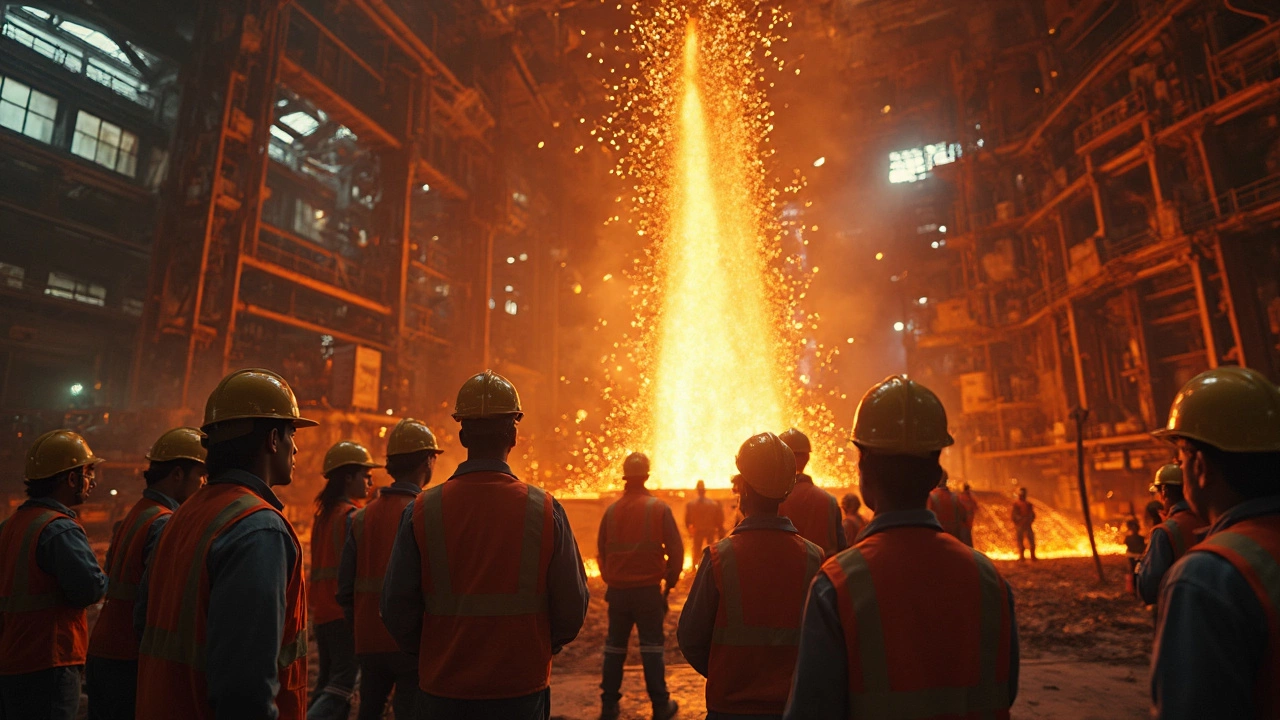Looking for the state that churns out the most steel in the U.S.? It’s not even a close race—Indiana takes the crown by a mile. This state alone accounts for roughly a quarter of all steel produced nationally, with giants like U.S. Steel’s Gary Works leading the pack. Everywhere you look in northwest Indiana, there’s another smokestack or chunk of a giant mill dominating the horizon.
There’s a reason Indiana keeps this title. The whole region sits right on Lake Michigan, offering easy access to shipping routes for iron ore and coal, which are the main ingredients for basic steel making. The transport’s quick, the infrastructure is built for heavy industry, and the workforce knows steel like the back of their hands.
- Steel Giants: States Leading the Charge
- Why Location Matters in Steel Production
- Indiana: The Steel Capital of America
- Behind the Scenes: Life Inside a Steel Plant
- Exploring Further: Resources and Plant Tours
Steel Giants: States Leading the Charge
If you line up the biggest steel manufacturing states, Indiana stands tall at the top. Not only does it hold the national lead, but it also churns out over 24% of all U.S. raw steel yearly. No other state even comes close—Indiana is the heart of US steel production.
Right behind Indiana, you'll spot Ohio, Pennsylvania, and Illinois making a mark in steel manufacturing. These states used to be the traditional centers, thanks to their access to lakes, rivers, and the Midwest’s sprawling transportation network. Together, these four powerhouses pump out most of America’s steel every year.
| State | Annual Steel Production (million tons, 2023) |
|---|---|
| Indiana | 24.3 |
| Ohio | 10.7 |
| Pennsylvania | 7.6 |
| Illinois | 5.5 |
Indiana owes a lot to massive plants like the Gary Works and ArcelorMittal’s Indiana Harbor, both sitting right by Lake Michigan. These aren’t small operations—they’re among the largest steel manufacturing plants across the country, feeding the auto and construction industries. If your car, fridge, or even washing machine is made in America, there’s a sporting chance the steel came from these states.
What sets these states apart? It’s all about logistics. Being near the Great Lakes makes it cheaper and faster to get raw materials in and finished steel out. Plus, these places have kept their expertise alive for generations. While a few southern states like Alabama and Texas are stepping up, the core of US steel production is still up north—just like it has been for more than a century.
Why Location Matters in Steel Production
If you’re wondering why states like Indiana dominate steel manufacturing, it really comes down to where you’re located on the map. This industry isn't just about melting scrap in a furnace; it’s about moving millions of tons of raw material. Heavy stuff like iron ore and coal has to get to the plant, finished steel has to leave, and all this takes serious infrastructure.
Major steel mills need to be near transportation hubs. This means close to the Great Lakes, major rivers, railroad crossroads, or even big highway systems. Indiana checks pretty much every box with its spot on Lake Michigan. Ships bring in iron ore from Minnesota, and coal travels easily by rail from the Appalachian region. Then, that finished steel can leave on a barge, a train, or a truck, heading straight for factories, construction sites, or car plants all over the country.
The right location also means lower costs. Shipping raw stuff is expensive, so if you can cut the distance, you save millions every year. You also want a place with a skilled workforce and energy sources nearby, since running a furnace 24/7 eats up more juice than a city of small towns. Even simple things, like access to freshwater for cooling, shape where a plant can survive long term.
- Steel industry plants in Indiana receive over 20 million tons of iron ore, coal, and limestone every year, mostly thanks to Lake Michigan docks and rail access.
- Plants in less ideal locations face costs up to 30% higher, just from extra shipping and logistics headaches.
- That's why you don’t see many new massive steel plants popping up far from ports or rail—nobody wants to pay more just to move the basics.
This is why the map of steel production in the U.S. isn’t random at all. It’s about location, location, location—and nowhere is this clearer than in America’s steel industry heartland.

Indiana: The Steel Capital of America
When people talk about steel manufacturing in the US, Indiana almost always pops up first. If you drive through northwest Indiana, especially along the I-90 corridor, you’ll notice instantly—this region’s entire landscape is shaped by massive steel plants. Places like Gary, Burns Harbor, and East Chicago have entire neighborhoods built around steel’s rise and grind.
What really sets Indiana apart is its muscle in actual numbers. For over 40 years, Indiana has produced more steel than any other state, not just by a hair, but by nearly double the output of the next state. In 2023, for example, Indiana cranked out over 25% of all domestic raw steel, which put its total output at about 24 million tons for the year. The main players—U.S. Steel’s Gary Works, Cleveland-Cliffs in East Chicago, and ArcelorMittal (now owned by Cleveland-Cliffs) in Burns Harbor—are the big engines keeping this whole operation running.
| Major Indiana Steel Plant | Estimated Annual Capacity (Million Tons) |
|---|---|
| U.S. Steel Gary Works | 7.5 |
| Cleveland-Cliffs Burns Harbor | 5 |
| Cleveland-Cliffs East Chicago | 3.5 |
Why here? Indiana nails the logistics game. These mills hug the Lake Michigan shoreline, so they get easy barge delivery of iron ore straight out of Minnesota and Michigan. The interstate system and a massive rail network mean finished steel can head across the Midwest or right to the East Coast without breaking a sweat.
Another big factor: tradition and talent. Families have worked in these plants for generations. Local training programs and trade schools partner directly with the mills. If you’re considering a career in steel manufacturing, this is one state where training leads to real jobs fast. Most mills offer solid pay and union benefits, which is why many Hoosiers stick with the trade for decades.
Anyone serious about tracking US steel production or thinking about business in the Midwest should keep an eye on Indiana. The numbers, the know-how, and the infrastructure all come together here like nowhere else in the country.
Exploring Further: Resources and Plant Tours
If you’re itching to see how massive steel manufacturing really happens, you’ve got some cool options. Indiana, with its long history in US steel production, is home to sites like the Gary Works of U.S. Steel. Some steel plants in the Midwest open their doors for guided tours—sometimes for students, sometimes for curious locals or industry buffs.
When it comes to finding info on these tours, start with the companies’ official websites. For example, ArcelorMittal (now part of Cleveland-Cliffs) sometimes offers community tours at its Burns Harbor mill. Even if full plant tours aren’t listed, many companies share videos and virtual experiences. Keep an eye out for annual events like SteelDay. The American Institute of Steel Construction (AISC) and the Association for Iron & Steel Technology (AIST) both announce tours and open houses across Indiana and other steel plants around the country.
For tracking what’s happening in the steel industry—prices, tonnage, or company news—the American Iron and Steel Institute (AISI) site is gold. Want real-time stats? Check out their weekly production tables. Here’s a peek at a recent one for Indiana and other big producers (just to give you an idea):
| State | Weekly Steel Output (Tons) |
|---|---|
| Indiana | 460,000 |
| Ohio | 210,000 |
| Pennsylvania | 195,000 |
| Illinois | 90,000 |
Interested in going deeper? Some must-visit resources for updates, networking, and learning include:
- Steel Manufacturers Association – Focuses on electric arc furnace producers and hosts online resources.
- AIST Events Page – Lists industry conferences, steelmaking tours, and local chapter meetings.
- National Museum of Industrial History in Bethlehem, Pennsylvania – Great stop for steel history and legacy exhibits if you want to see where it all began.
Booking a plant tour? Always read the company’s safety info. Most plants require visitors to wear closed-toe shoes, hard hats, and safety goggles. They’ll tell you everything else you need to know before you walk in—just don’t show up in flip-flops expecting a selfie by a blast furnace.






Write a comment